If the electric window is making a cracking noise or dropping at an angle, or not moving at all, the cause is probably the fitting of the glass to the window regulator.
The earlier design featured a padded channel where the glass sits, and a nylon 'finger' that snaps into the hole in the glass. These are part of a white nylon block, which as well as making cracking sounds at the ends of the travel, actually cracks right down the centre. It can be fastened back together with a metal strip and screws, but sooner or later, it will jam and stop working anyway.
The later design, which is what you get when you order a replacement regulator, has a pin that passes through the glass. A clip is fitted on the other side. The new design does not attempt to support the glass, and therefore, seems not to produce the cracking sounds and is not prone to jamming.
View attachment 175109
However, the later design has the motor on the other side of the regulator, so the original wiring plug will not reach. A replacement plug is supplied with the motor. This needs to be attached to the wiring in some fashion (crimp connectors, soldering, terminal block, etc.) and, of course, the wiring colours do not match.
It's all part of the fun - which you will see illustrated in this guide.
Step 1 - remove the door panel
Start by prying off the shiny chrome escutcheon from around the door release interior handle - use your fingers or a screwdriver carefully applied. See photo 1 for the location of the clip (towards the back of the door). There is now a hex cap screw exposed - undo this with a 5mm Allen key or socket bit. I use an electric impact driver to speed things up. But there is nothing wrong with basic hand tools. A useful tip is to use a deep-reach socket (5mm to 8mm) to extend the short part of an Allen key - gives you a bit more torque to loosen tight screws.
Flip out the plastic panel in the door pull as shown. This exposes two more 5mm hex cap screws; undo these.

Now pry the door panel off the door. It helps if you have a trim removal tool, but a flat screwdriver or other wide implement will suffice, as you can't really see where to pry anyway until you get it moving. Start near the back edge of the door underside (where shown in the second photo) - some scratching of the paint is likely and you might try applying some masking tape to reduce the risk.
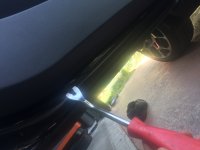
Once the door panel is loosened along the bottom, pull it off with your hands.
As the panel comes away, release the cable from the door release interior handle. It has a swivelling clip which you can pop off the inner cable first, then pull the outer cable from the handle housing.
The white foam sheet fastened to the door requires care to remove. Resist the temptation to peel at the edge with your fingers - it will rip sooner or later. Instead, get a sharp knife and cut around any yellow grommets that are pressed through the sheet.
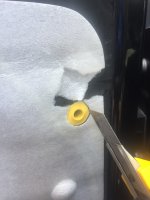
Then use the knife to cut through the adhesive bead as you peel the sheet off carefully. The adhesive will later re-join where you have cut it.
It isn't possible to remove the sheet completely unless you remove the riveted-on speaker housing. So, just cut the adhesive most of the way around and allow the sheet to hang down over the speaker - you'll have plenty of access for replacing the window regulator this way.
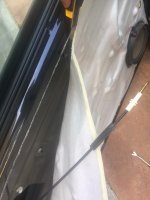
The next step is the removal and refitting of the regulator...
The earlier design featured a padded channel where the glass sits, and a nylon 'finger' that snaps into the hole in the glass. These are part of a white nylon block, which as well as making cracking sounds at the ends of the travel, actually cracks right down the centre. It can be fastened back together with a metal strip and screws, but sooner or later, it will jam and stop working anyway.
The later design, which is what you get when you order a replacement regulator, has a pin that passes through the glass. A clip is fitted on the other side. The new design does not attempt to support the glass, and therefore, seems not to produce the cracking sounds and is not prone to jamming.
View attachment 175109
However, the later design has the motor on the other side of the regulator, so the original wiring plug will not reach. A replacement plug is supplied with the motor. This needs to be attached to the wiring in some fashion (crimp connectors, soldering, terminal block, etc.) and, of course, the wiring colours do not match.
It's all part of the fun - which you will see illustrated in this guide.
Step 1 - remove the door panel
Start by prying off the shiny chrome escutcheon from around the door release interior handle - use your fingers or a screwdriver carefully applied. See photo 1 for the location of the clip (towards the back of the door). There is now a hex cap screw exposed - undo this with a 5mm Allen key or socket bit. I use an electric impact driver to speed things up. But there is nothing wrong with basic hand tools. A useful tip is to use a deep-reach socket (5mm to 8mm) to extend the short part of an Allen key - gives you a bit more torque to loosen tight screws.
Flip out the plastic panel in the door pull as shown. This exposes two more 5mm hex cap screws; undo these.

Now pry the door panel off the door. It helps if you have a trim removal tool, but a flat screwdriver or other wide implement will suffice, as you can't really see where to pry anyway until you get it moving. Start near the back edge of the door underside (where shown in the second photo) - some scratching of the paint is likely and you might try applying some masking tape to reduce the risk.

Once the door panel is loosened along the bottom, pull it off with your hands.
As the panel comes away, release the cable from the door release interior handle. It has a swivelling clip which you can pop off the inner cable first, then pull the outer cable from the handle housing.
The white foam sheet fastened to the door requires care to remove. Resist the temptation to peel at the edge with your fingers - it will rip sooner or later. Instead, get a sharp knife and cut around any yellow grommets that are pressed through the sheet.

Then use the knife to cut through the adhesive bead as you peel the sheet off carefully. The adhesive will later re-join where you have cut it.
It isn't possible to remove the sheet completely unless you remove the riveted-on speaker housing. So, just cut the adhesive most of the way around and allow the sheet to hang down over the speaker - you'll have plenty of access for replacing the window regulator this way.

The next step is the removal and refitting of the regulator...
Swapping the regulator and wiring the plug
It would be a good idea to lower the window as far as you can, perhaps by having an assistant operate the switch while you push down on the glass, etc. If this is not possible, you will still be able to remove the glass from the regulator but it will be more of a struggle than if the window were lowered first.
Unplug the motor plug - you might need to pull out the yellow part of the plastic clip first.
Undo the three 10mm nuts that hold the regulator to the door.
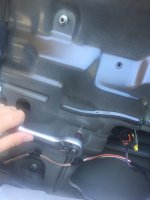
Reach inside the door and locate the spring finger that holds the glass to the regulator - release it while pushing the glass up a little. This is quite straightforward, but in the words of Deckchair5 (from the Stilo forum, ten years ago) - "practice first by shuffling a deck of cards, upside down, in the dark, with one hand"
Remove the regulator through the largest hole in the door metalwork.
Marvel at the differences between the original regulator and the replacement part - here they are side-by-side again:
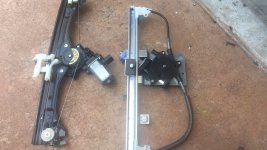
Fit the replacement plug (supplied) to the regulator motor - it is easier to do this before the regulator is fitted to the door, as the plug is a tight fit. Pass the wiring between the securing bracket and the door, to prevent any chance of the wiring getting tangled by moving parts.
I suggest wrapping the wiring with foam tape to reduce the risk of chafing/insulation damage.

Fit the new regulator into the door. It will probably arrive with one or more bolts fitted - remove these and use them in lieu of the original nuts. Leave nuts and bolts loose at this stage.
Cut the original plug off the door wiring. Shorten the wires of the replacement plug to an appropriate length - always leave a little excess - and strip the insulation. I recommend soldering the wires and the use of heat shrink tubing, but you could also use crimp connectors (blue size) which would be faster. A final option is a screw terminal block; reliable, but looks a bit of a bodge.
For the left door,
Blue wire of replacement plug - purple and yellow wire of car's wiring
Blue and black wire of replacement plug - purple and green wire of car's wiring

It helps if the window regulator is fully lowered before fitting the glass to the regulator. Now that the wiring is attached, you can of course achieve this by using the switch.
Fit the pin of the regulator through the glass and attach the C-shaped clip onto the outside of the glass.

Complete the wrapping of any exposed wiring using foam tape (or similar).
Tighten the regulator nuts/bolts and test the window operation before refitting the white foam sheet and door panel.
You will probably find that the newer-style regulator operates faster than the old-style regulator. Perhaps you will now replace the other window regulator as well

